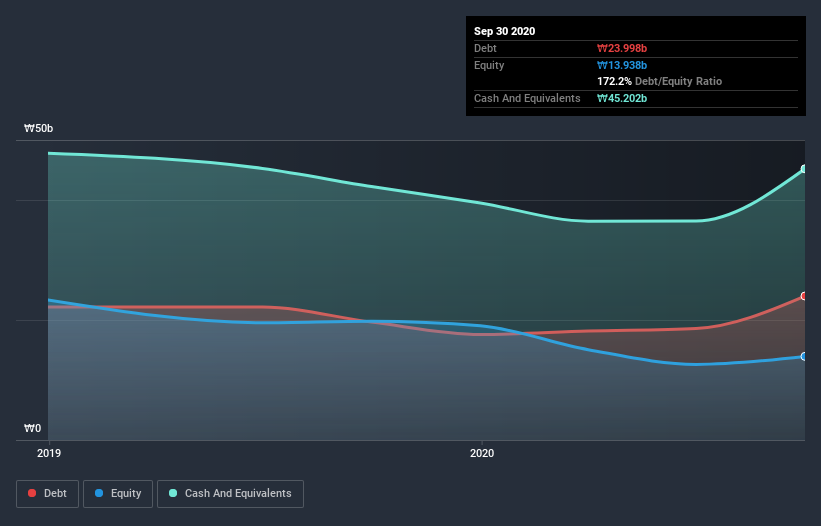
Warren Buffett famously said, 'Volatility is far from synonymous with risk.' It's only natural to consider a company's balance sheet when you examine how risky it is, since debt is often involved when a business collapses. We can see that EyeGene Inc. (KOSDAQ:185490) does use debt in its business. But the more important question is: how much risk is that debt creating?
When Is Debt A Problem?
Generally speaking, debt only becomes a real problem when a company can't easily pay it off, either by raising capital or with its own cash flow. In the worst case scenario, a company can go bankrupt if it cannot pay its creditors. While that is not too common, we often do see indebted companies permanently diluting shareholders because lenders force them to raise capital at a distressed price. Of course, debt can be an important tool in businesses, particularly capital heavy businesses. When we think about a company's use of debt, we first look at cash and debt together.
Check out our latest analysis for EyeGene
How Much Debt Does EyeGene Carry?
As you can see below, at the end of September 2020, EyeGene had ₩24.0b of debt, up from ₩19.7b a year ago. Click the image for more detail. But it also has ₩45.2b in cash to offset that, meaning it has ₩21.2b net cash.

How Healthy Is EyeGene's Balance Sheet?
According to the last reported balance sheet, EyeGene had liabilities of ₩17.4b due within 12 months, and liabilities of ₩21.7b due beyond 12 months. On the other hand, it had cash of ₩45.2b and ₩1.01b worth of receivables due within a year. So it actually has ₩7.19b more liquid assets than total liabilities.
This short term liquidity is a sign that EyeGene could probably pay off its debt with ease, as its balance sheet is far from stretched. Succinctly put, EyeGene boasts net cash, so it's fair to say it does not have a heavy debt load! When analysing debt levels, the balance sheet is the obvious place to start. But it is EyeGene's earnings that will influence how the balance sheet holds up in the future. So when considering debt, it's definitely worth looking at the earnings trend. Click here for an interactive snapshot.
In the last year EyeGene had a loss before interest and tax, and actually shrunk its revenue by 12%, to ₩3.6b. We would much prefer see growth.
So How Risky Is EyeGene?
By their very nature companies that are losing money are more risky than those with a long history of profitability. And the fact is that over the last twelve months EyeGene lost money at the earnings before interest and tax (EBIT) line. Indeed, in that time it burnt through ₩11b of cash and made a loss of ₩15b. But the saving grace is the ₩21.2b on the balance sheet. That kitty means the company can keep spending for growth for at least two years, at current rates. Even though its balance sheet seems sufficiently liquid, debt always makes us a little nervous if a company doesn't produce free cash flow regularly. There's no doubt that we learn most about debt from the balance sheet. But ultimately, every company can contain risks that exist outside of the balance sheet. To that end, you should learn about the 4 warning signs we've spotted with EyeGene (including 1 which is makes us a bit uncomfortable) .
If you're interested in investing in businesses that can grow profits without the burden of debt, then check out this free list of growing businesses that have net cash on the balance sheet.
If you’re looking to trade EyeGene, open an account with the lowest-cost* platform trusted by professionals, Interactive Brokers. Their clients from over 200 countries and territories trade stocks, options, futures, forex, bonds and funds worldwide from a single integrated account. Promoted
Valuation is complex, but we're here to simplify it.
Discover if EyeGene might be undervalued or overvalued with our detailed analysis, featuring fair value estimates, potential risks, dividends, insider trades, and its financial condition.
Access Free AnalysisThis article by Simply Wall St is general in nature. It does not constitute a recommendation to buy or sell any stock, and does not take account of your objectives, or your financial situation. We aim to bring you long-term focused analysis driven by fundamental data. Note that our analysis may not factor in the latest price-sensitive company announcements or qualitative material. Simply Wall St has no position in any stocks mentioned.
*Interactive Brokers Rated Lowest Cost Broker by StockBrokers.com Annual Online Review 2020
Have feedback on this article? Concerned about the content? Get in touch with us directly. Alternatively, email editorial-team@simplywallst.com.
About KOSDAQ:A185490
EyeGene
Engages in the research and development of biopharmaceutical drugs for the treatment and prevention of age-related diseases in South Korea.
Flawless balance sheet low.
Market Insights
Community Narratives


